We may earn revenue from the products available on this page and participate in affiliate programs. Learn More ›
If asked to name the most remarkable rifle introduced in the last year, I’d have to go with the Seekins Havak HIT. The feature set, performance, innovation, and surprisingly affordable price elevate it to a category of its own. No other new rifle—and there’ve been a bunch of good ones trotted out in the last 12 or 13 months—is its equal.
The Seekins Havak HIT performed very well at Outdoor Life’s 2022 Gun Test, earning not only Great Buy and Innovation awards in a stacked field, but the hearts of the gun test team, all of whom were wowed by this switch-barrel precision rifle.
The rifle is accurate, of course, and chambered in 6.5 PRC turned in 5-shot groups that averaged .542 inches with factory ammo. That’s the average of twenty 5-shot groups, by the way.
The Seekins Havak HIT looks as good as it shoots, built on an attractive folding chassis stock of Glen Seekin’s own design. In fact, one of the very appealing aspects of the Havak HIT is that all the components are made in-house by Seekins, except for the trigger and grip.
Many firearms manufacturers use components sourced from other companies. The practice has long been common, but in today’s world of mix-and-match parts it is even more widespread. No one bats an eye at a company who takes a Proof barrel, Mack Brothers action, and a KRG stock and slaps their logo on it. This is why it is refreshing to see someone like Seekins design a rifle from the ground up.
- Action: Four-lug bolt (two rows of two)
- Stock: Folding aluminum chassis
- Caliber: 6.5 PRC/6mm GT (tested); 6mm Creed, 6.5 Creed, and .308 Win. also available
- Capacity: 5-round AICS magazine
- Weight: 11 pounds 4 ounces (measured)
- Trigger: 2 pounds 8 ounces, adjustable (measured)
- Barrel: 24 inches, M24 contour, threaded 5/8-24
- Length: 43.5 inches
- Extractor: M-16 style
- Ejector: Single plunger
- Price: $2,100
Seekins Havak HIT vs. Havak HIT Pro
Since the rifle was introduced a year ago, Seekins unveiled a second version call the Seekins Havak HIT Pro. The difference between the two is that that Pro comes equipped with a couple extra components and some upgrades.
Specifically, the Pro includes one of Seekins’ full-length ARCA rails pre-mounted to the M-Lok slots on the chassis’ fore-end. It also comes with a muzzle break, which the standard version does not. Lastly, the trigger is an upgraded model from Timney that can be set from 8 ounces to 2 pounds. The Pro is meant to be competition ready out of the box, while the standard Havak HIT needs a muzzle device and a rail at the very least.
Going with the Seekins Havak HIT Pro adds about $400 to the rifle’s price. But it can be cost-effective to just add the ARCA rail to the standard model for $129 if you already have a suppressor or break to run. You’re not giving up much with the standard model’s trigger. Mine broke at a crisp and even 2 pounds, 8 ounces, which isn’t bad by any means. In either trim, the rifle is still a good value.
Easy Switch-Barrel System
Switch barrel designs, particularly with precision rifles, have become more commonplace and generally simpler to use. The barrel-swap system on the Seekins Havak HIT couldn’t be more intuitive.
You screw barrels into and out of the action and tighten a single Torx T-15 fastener to hold them in place. The fastener is conveniently located at the front of the integral Picatinny rail on the right side of the rifle.
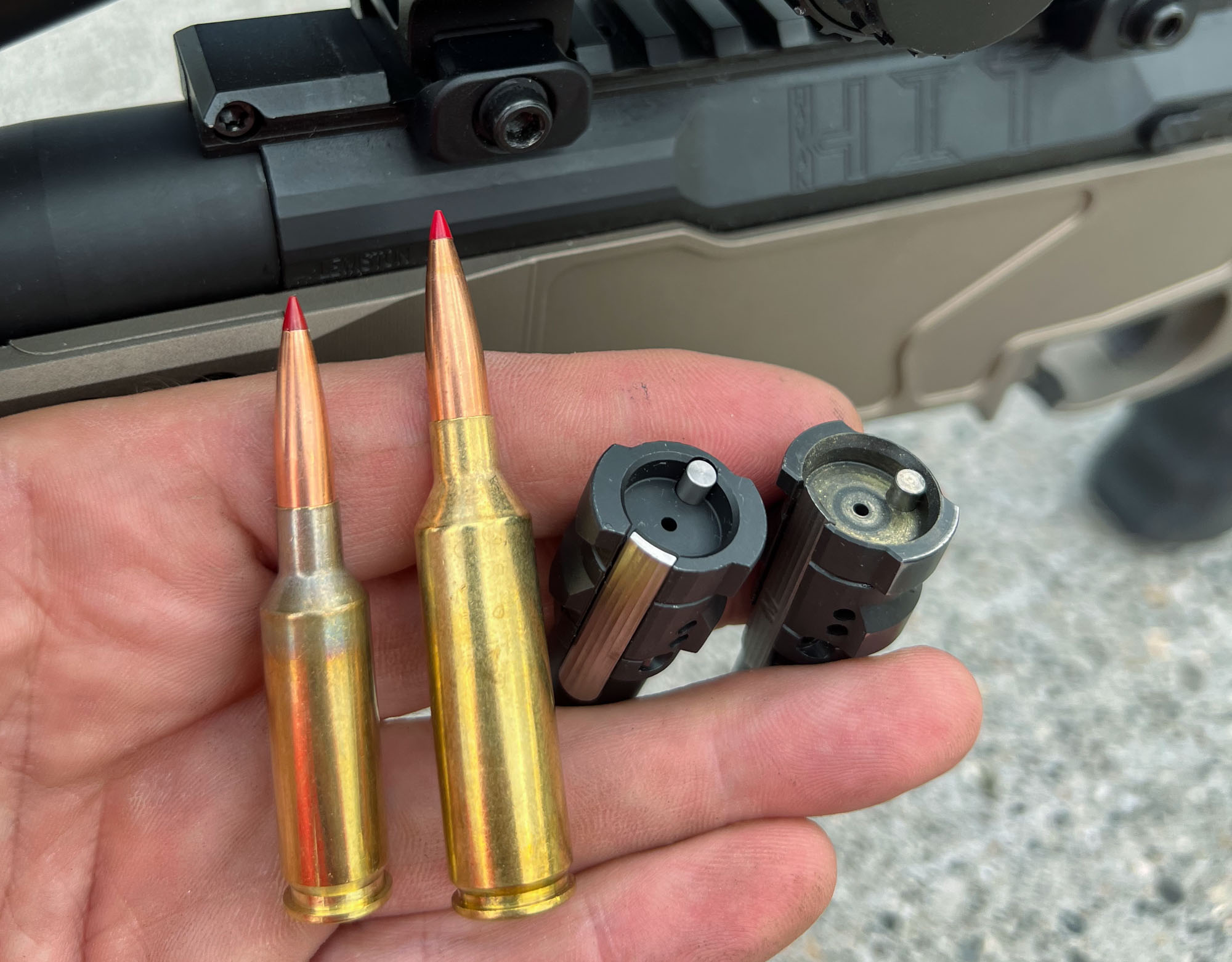
Toolless Bolt Head Change
Converting to cartridges that require a different sized bolt face is nearly as easy. The bolt doesn’t require tools to take it apart. A twist on the bolt shroud allows the shroud and firing pin assembly to come free.
After that you tap out the cylindrical pin that holds the bolt head in place and swap one bolt head for another. The tail end of the M-16 style extractor on the bolt head is slightly raised. That indexes with a cutout in the bolt body making it impossible to insert the bolt head the wrong way.
The only mildly challenging bit of the process is correctly orienting the pin that holds the bolt head in place. It has a hole drilled through it to accommodate the firing pin. After dropping the pin in place just look through the back of the bolt. If you can see daylight, you’re good. Keeping the whole barrel- and caliber-change procedure idiot-proof is one of rifle’s many fine qualities.
Smooth Action, Reliable Feeding
The Seekins Havak HIT has a full diameter bolt body, meaning the body is as wide as the bolt lugs. This has a couple advantages. One, actions designed this way tend to run smoothly since there’s ample contact between the bolt body and the raceway cut in the receiver. This keeps bolt chatter and binding to a minimum.
Secondly, this allowed Seekins to orient the lugs in the 12- and 6-o’clock position while the bolt is being run. This helps the rifle feed smoothly from the magazine because of the significant contact between the downward facing lug and the cartridge case head.
As an added measure to ensure reliable feeding, the height of the magazine catch can be altered. Changing the catch height will cause the magazine to sit higher or lower in the mag well, letting the operator tune the rifle to the magazines being used. I didn’t need to touch mine, which ran fine with the 5-round polymer AICS magazine that the rifle shipped with.
Accuracy Enhancements
The action is machined with an integral recoil lug and has more threads for the barrel—meaning the barrels have a longer tenon—than does a typical Remington 700-pattern action. It’s topped with an integral Picatinny rail with 20 MOA of declination and the ejection port is enclosed, too. All these features add weight, and stiffness, to the action. Gun nerds will debate until they’re red in the face whether these qualities contribute to rifle accuracy. But no one can argue that they hurt. And the level of precision that the Seekins Havak HIT delivered speaks for itself.
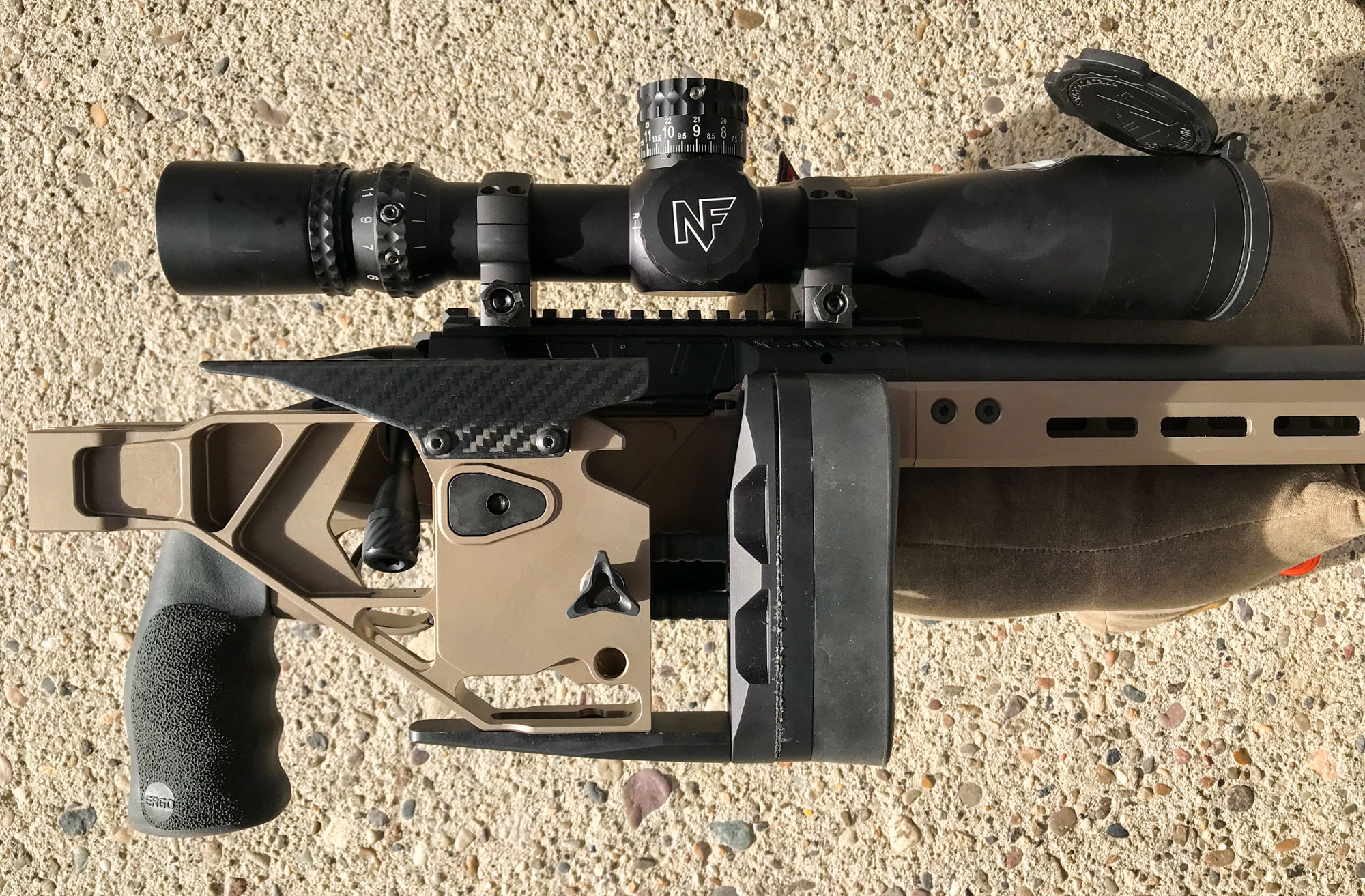
Seekins Havak HIT Folding Chassis
The chassis on the rifle is one of the more elegant systems out there, both in terms of looks and function. Many aluminum rifle chassis have blocky lines that aren’t very appealing, and that clunky affect is often made worse by the presence of the knobs and levers used to alter the chassis’ dimensions.
The chassis on the Havak HIT mitigates this by incorporating a lot of cuts that break up the sharp lines on the edges, and by removing a lot of material from various places, especially around the butt stock.
The folder is actuated by a spring-loaded button that causes the stock to fold over the bolt handle and ejection port. The hinge moves smoothly, and the release button is easy to operate. In the locked position the chassis betrays only the slightest amount of wiggle—certainly not enough to affect performance.
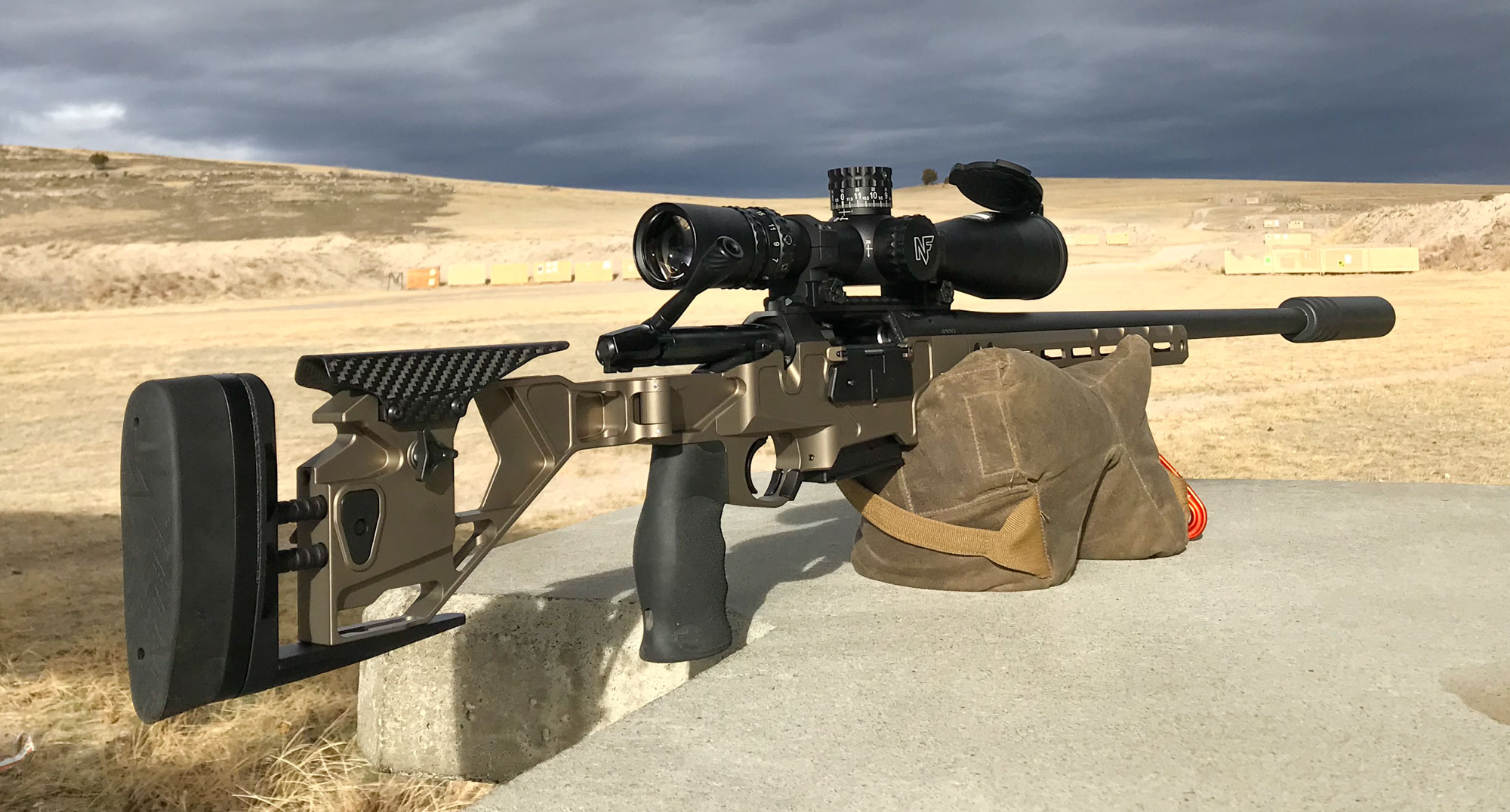
Chassis Adjustments
The chassis has two knobs on the butt stock. One controls length of pull, the other is to adjust comb height. Both length of pull and comb height can be increased by about 1.4 inches—which is more than sufficient for any user.
The recoil pad, which is an inch thick, pleasantly cushy, and effective, attaches to an assembly that includes a gently sloping bag rider. The bag rider is minimalistic but has plenty of surface area to contact a support bag.
The cheek piece is formed of carbon fiber. It’s slick and comfortable and glides against the shooter’s cheek under recoil without hanging up. It’s also rigid and strong, providing a positive and repeatable index point for the shooter’s head.
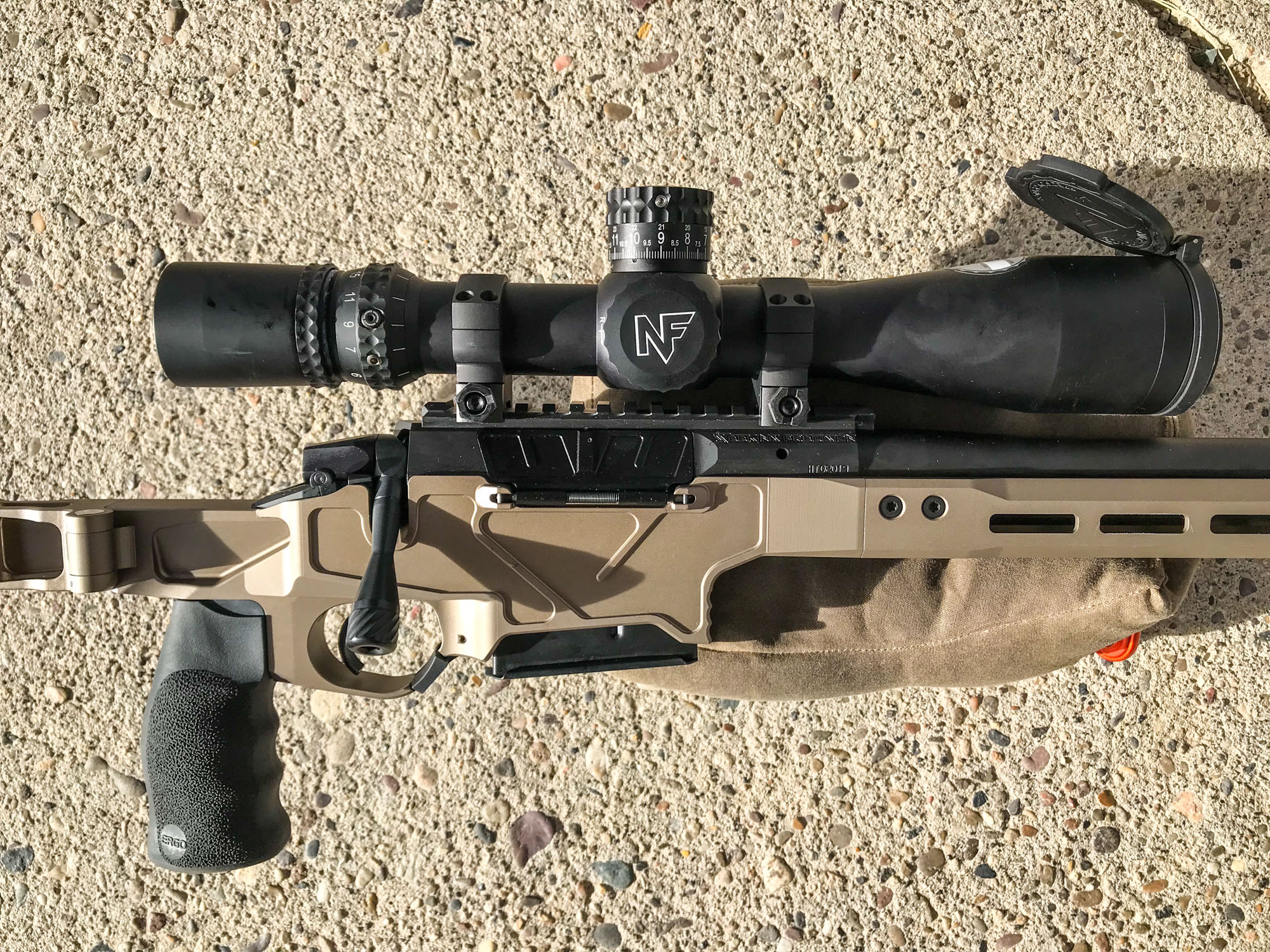
Other Notable Chassis Features
The chassis includes a dust cover that folds over the ejection port and springs open when the bolt is lifted. That’s a nice feature to help keep grit, mud, rain, and snow out of the action between stages at competitions. It looks and operates like dust covers on AR-type rifles.
Magazine Release
The magazine release tab is incorporated into the trigger guard and has two generously sized paddles that are easy to manipulate from either side. The trigger guard has machined recesses for the tabs. So even though the tabs have a fair bit of surface area to push against, they don’t stick out much beyond the edges of the trigger guard. Another smart design touch.
M-Lok Slots, QD Cups and Night-Vision Mount
The fore-end also has 6 M-Lok slots at the 3-, 6-, and 9-o’clock positions, for a total of 18 attachment points. You can also add Seekins HIT NVM ($189) to the fore-end if desired to mount a night vision device.
To mount a sling, the stock has QD cups machined into the butt stock and along the fore-end.
Barricade Block and AR-Style Grip
Just in front of the mag well is a ridged barricade block, so you can drive the chassis against a support to steady the shot and not put pressure on the magazine.
The grip on the rifle, made by Ergo Grip, is vertical and constructed from rubber with medium contour finger grooves. I like how it positioned my shooting hand, but if you don’t care for it you can easily swap it for any other A2 compatible pistol grip.
Though the chassis doesn’t have a dedicated thumb shelf there’s a small relief cut in the stock where I could rest the thumb of my trigger hand—but wrapping my thumb around the grip didn’t seem to compromise my trigger control either.
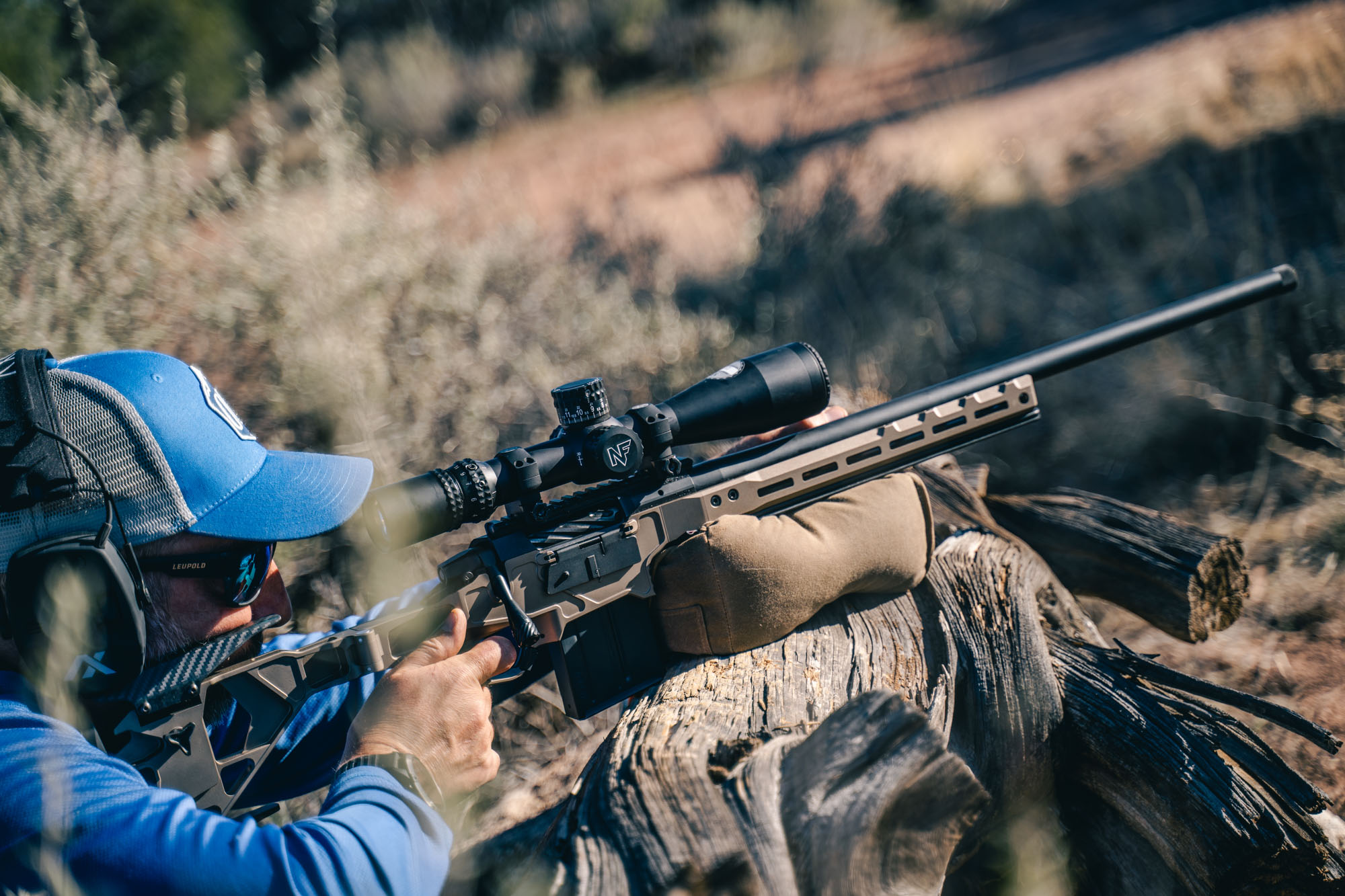
Running the Seekins Havak HIT
You don’t have to be John Browning to recognize that many of the features I’ve enumerated so far help a rifle run better. And when added together they turn the Seekins Havak HIT into a superior shooter.
When prone, the rifle tracks smoothly back and forth with a recoil impulse that’s easy to manage in 6.5 PRC. When dropping down to the 6 GT, the Havak HIT is even more biddable.
The ARCA rail on the fore-end allows you to position a bipod anywhere along its length. You can keep it within reach of your non-trigger hand to make adjustments without lifting your head off the stock. You can also pull the bipod close to pinch a support bag between it and the barricade block for a solid rest.
Well Balanced
The rifle’s balance point is just forward of the mag well and when you add on a substantial bipod and muzzle device it takes on a weight-forward attitude. Most shooters prefer their rifle to be a bit heavier up front. It helps counter muzzle rise under recoil allowing the shooter to maintain a better sight picture.
That said, I wouldn’t mind the option to add a bit more weight to the butt of the rifle because when running a heavier bipod and a heavy suppressor I found the rifle to be a bit more nose heavy than I liked.
Positional Pro
While all the accuracy testing was done shooting prone, I spent a great deal of time running the Seekins Havak HIT from various positions, as you’d encounter in a tactical field match. Using it in conjunction with an Armageddon Gear Game Changer it worked great off barricades and obstacles. I shot it from tree branches, stumps, boulders, off tripods, and while moving in and out of cramped cages and other props. Along with the other gun test team members we ran it through Gunsite Academy’s famed Scrambler.
The rifle is heavy enough that it settles quickly into place but is still light enough to maneuver without struggling. It shines from any shooting position. It’s a very capable system.
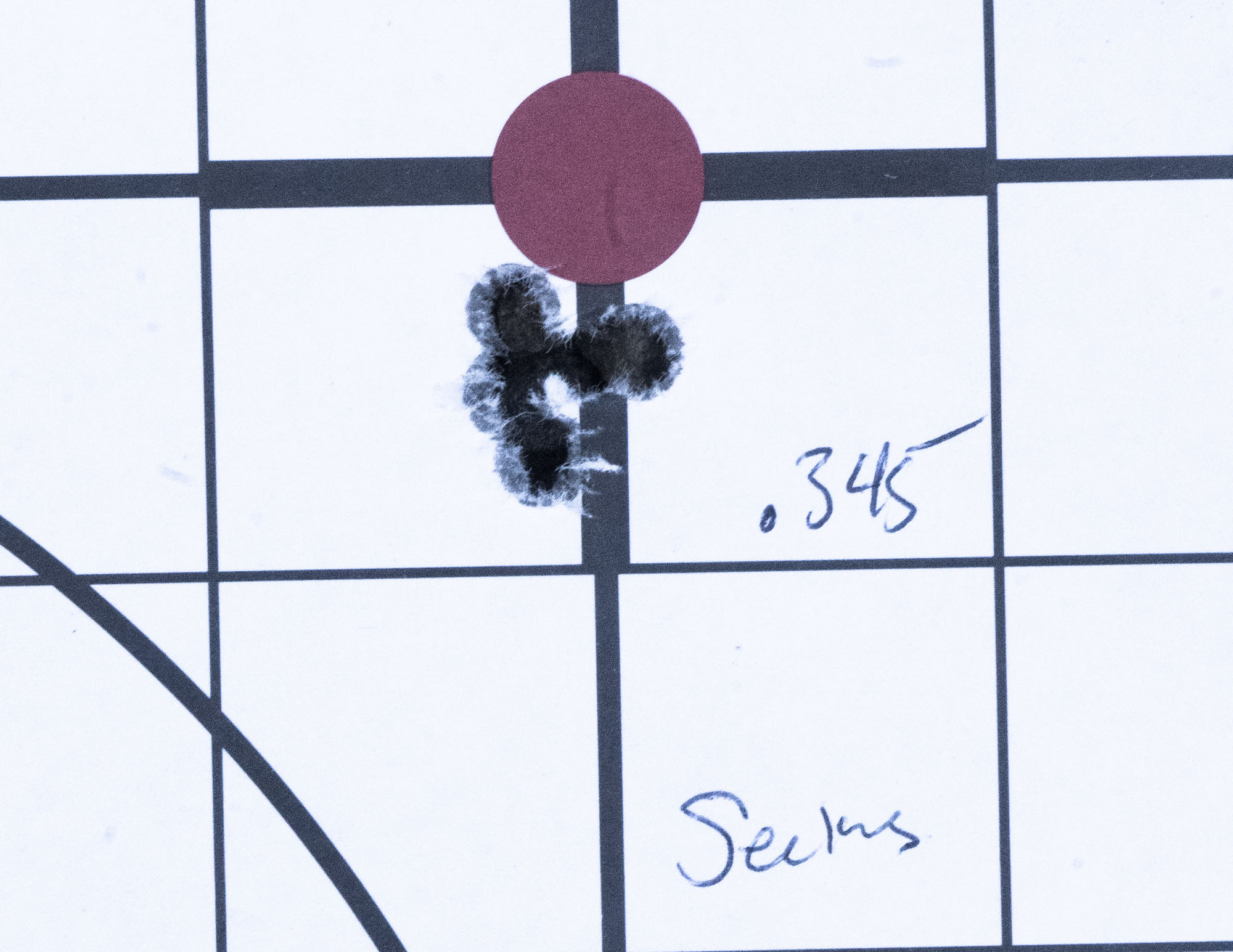
How Reliable Is The Seekins Havak HIT?
I’ve been using the rifle for a year now, and have put several hundred rounds through it in both 6.5 PRC and 6mm GAP GT. I’ve had zero issues with it. It has fed, extracted, and ejected every round I’ve chambered. Though I check the tightness of the fasteners on all my rifles regularly, I’ve never had one on the Havak HIT work loose.
The finish on the bolt show signs of wear, but is nothing out of the ordinary.
What The Seekins Havak HIT Does Well
This is a versatile precision rifle that can be used in competition or taken hunting. It isn’t really an ideal PRS rig—it’s too light—but for matches that require a lot of movement and where too much weight isn’t a good thing it’ll be right at home. In the NRL Hunter series it can hit the 16-pound threshold for the Open Heavy division, for instance, and be competitive there.
Though not a rifle you’d want to take into the backcountry, it’d work great on predators where the hike from the truck isn’t too far. And it would be a good fit for stand hunting, particularly in a beanfield scenario where longer shots can be expected. For ringing steel at long ranges the rifle is perfect.
Where It Could Improve
One gripe I have with the rifle is pretty minor and easily addressed. The bolt handle on the action is a tad short and skinny for my liking. Because it is threaded, however, swapping it for something that provides a bit more leverage and grip area isn’t a problem.
The other issue with it is the same problem I see with most aluminum chassis rifles. That is, it is made of aluminum. And when you live in a place like Montana where it is frequently cold, that can make for some uncomfortable shooting. The grip is made of rubber, which is great, but the fore-end has nothing but cool aluminum to hold on to. Not a deal-breaker. You just need to remember your gloves.

Final Thoughts on the Seekins Havak HIT
I have a very high opinion of this rifle—especially in light of its $2,100 MSRP. (Though the street price is just under two grand.) The list of features and refinements are typical of what you’d see on rifles costing twice as much—and in all honesty, the Seekins Havak HIT not only can hold its own with that crowd but will outperform many of them as well.
That kind of cost savings can easily be rolled into getting a better scope (always a good idea), or paying for some instruction (also a great idea).
This makes the Seekins Havak HIT a true rifleman’s rifle, which is about the highest praise I can bestow on a long gun.
